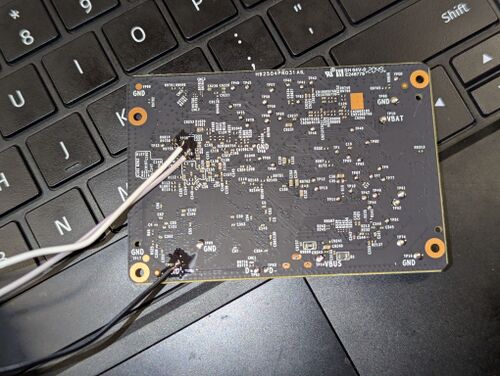Xiaomi Mi Smart Clock (xiaomi-x04g): Difference between revisions
Appearance
m mmc works, flashing works |
No edit summary |
||
| Line 99: | Line 99: | ||
== Installation == | == Installation == | ||
Use [[pmbootstrap]] to build your own installation image. | Use [[pmbootstrap]] to build your own installation image. | ||
== Partition layout == | |||
<pre> | |||
1: proinfo | |||
2: nvram | |||
3: persist | |||
4: seccfg | |||
5: lk | |||
6: lk2 | |||
7: boot | |||
8: recovery | |||
9: para | |||
10: logo | |||
11: dtbo | |||
12: expdb | |||
13: frp | |||
14: tee1 | |||
15: tee2 | |||
16: kb | |||
17: dkb | |||
18: md_udc | |||
19: metadata | |||
20: nvdata | |||
21: vbmeta | |||
22: vbmeta_system | |||
23: vbmeta_vendor | |||
24: super | |||
25: cache | |||
26: userdata | |||
</pre> | |||
== UART == | == UART == | ||
| Line 104: | Line 134: | ||
[[File:X04G-UART.jpg|500px|UART pins on the X04G board, click for higher resolution]] | [[File:X04G-UART.jpg|500px|UART pins on the X04G board, click for higher resolution]] | ||
== Bootloader log == | |||
<div class="toccolours mw-collapsible mw-collapsed" style="width: 800px; overflow: auto;"> | |||
<code> Bootloader log </code> | |||
<div class="mw-collapsible-content"> | |||
<pre> | |||
</pre> | |||
</div> | |||
</div> | |||
== See also == | == See also == | ||
* [https://github.com/Informatic/xiaomi-x04g-research GitHub project documenting some of the hardware with bootloader unlock instructions] | * [https://github.com/Informatic/xiaomi-x04g-research GitHub project documenting some of the hardware with bootloader unlock instructions] | ||
[[Category:Devices with known UART pinout]] | [[Category:Devices with known UART pinout]] | ||
Revision as of 05:53, 14 December 2024
|
Xiaomi Mi Smart Clock Xiaomi Mi Smart Clock | |
| Manufacturer | Xiaomi |
|---|---|
| Name | Mi Smart Clock |
| Codename | xiaomi-x04g |
| Model | X04G |
| Released | 2021 |
| Type | watch |
| Hardware | |
| Chipset | Mediatek MT8167S |
| CPU | 4x Cortex-A35 @ 1.3 GHz |
| GPU | Imagination PowerVR GE8300 |
| Display | 800x480 |
| Storage | 4GB eMMC |
| Memory | 1GB |
| Architecture | aarch64 |
| Software | |
| Original software | Android Things |
| Original version | 10 |
| postmarketOS | |
| Category | testing |
| Pre-built images | no |
| Mainline | partial |
| postmarketOS kernel | 6.11-rc4 |
| Flashing |
Works |
|---|---|
| USB Networking |
Works |
| Internal storage |
Works |
| Screen |
No data |
| Touchscreen |
No data |
| Multimedia | |
| 3D Acceleration |
No data |
| Audio |
No data |
| Connectivity | |
| WiFi |
No data |
| Bluetooth |
No data |
| Miscellaneous | |
| FDE |
No data |
| Sensors | |
| Ambient Light |
No data |
| Proximity |
No data |
Contributors
Users owning this device
How to enter flash mode
- Start mtkclient on your host
- Hold the volume up (+) button, then plug in the micro-USB cable from your host to the clock
Installation
Use pmbootstrap to build your own installation image.
Partition layout
1: proinfo 2: nvram 3: persist 4: seccfg 5: lk 6: lk2 7: boot 8: recovery 9: para 10: logo 11: dtbo 12: expdb 13: frp 14: tee1 15: tee2 16: kb 17: dkb 18: md_udc 19: metadata 20: nvdata 21: vbmeta 22: vbmeta_system 23: vbmeta_vendor 24: super 25: cache 26: userdata
UART
The smart clock has UART pins. It uses a baud rate of 921600. The pin labelled TP30 is TX, TP29 is RX. They are located on the back of the board.
Bootloader log
Bootloader log
